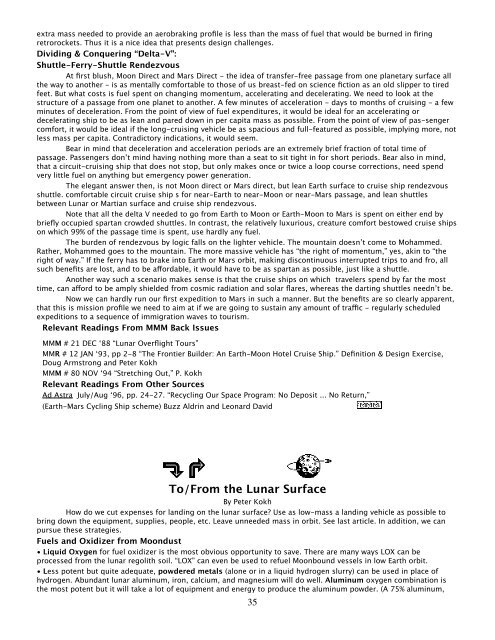Space Transportation - mmmt_transportation.pdf - Moon Society
Space Transportation - mmmt_transportation.pdf - Moon Society
Space Transportation - mmmt_transportation.pdf - Moon Society
You also want an ePaper? Increase the reach of your titles
YUMPU automatically turns print PDFs into web optimized ePapers that Google loves.
extra mass needed to provide an aerobraking profile is less than the mass of fuel that would be burned in firing<br />
retrorockets. Thus it is a nice idea that presents design challenges.<br />
Dividing & Conquering “Delta-V”:<br />
Shuttle-Ferry-Shuttle Rendezvous<br />
At first blush, <strong>Moon</strong> Direct and Mars Direct - the idea of transfer-free passage from one planetary surface all<br />
the way to another - is as mentally comfortable to those of us breast-fed on science fiction as an old slipper to tired<br />
feet. But what costs is fuel spent on changing momentum, accelerating and decelerating. We need to look at the<br />
structure of a passage from one planet to another. A few minutes of acceleration - days to months of cruising - a few<br />
minutes of deceleration. From the point of view of fuel expenditures, it would be ideal for an accelerating or<br />
decelerating ship to be as lean and pared down in per capita mass as possible. From the point of view of pas-senger<br />
comfort, it would be ideal if the long-cruising vehicle be as spacious and full-featured as possible, implying more, not<br />
less mass per capita. Contradictory indications, it would seem.<br />
Bear in mind that deceleration and acceleration periods are an extremely brief fraction of total time of<br />
passage. Passengers don’t mind having nothing more than a seat to sit tight in for short periods. Bear also in mind,<br />
that a circuit-cruising ship that does not stop, but only makes once or twice a loop course corrections, need spend<br />
very little fuel on anything but emergency power generation.<br />
The elegant answer then, is not <strong>Moon</strong> direct or Mars direct, but lean Earth surface to cruise ship rendezvous<br />
shuttle. comfortable circuit cruise ship s for near-Earth to near-<strong>Moon</strong> or near-Mars passage, and lean shuttles<br />
between Lunar or Martian surface and cruise ship rendezvous.<br />
Note that all the delta V needed to go from Earth to <strong>Moon</strong> or Earth-<strong>Moon</strong> to Mars is spent on either end by<br />
briefly occupied spartan crowded shuttles. In contrast, the relatively luxurious, creature comfort bestowed cruise ships<br />
on which 99% of the passage time is spent, use hardly any fuel.<br />
The burden of rendezvous by logic falls on the lighter vehicle. The mountain doesn’t come to Mohammed.<br />
Rather, Mohammed goes to the mountain. The more massive vehicle has “the right of momentum,” yes, akin to “the<br />
right of way.” If the ferry has to brake into Earth or Mars orbit, making discontinuous interrupted trips to and fro, all<br />
such benefits are lost, and to be affordable, it would have to be as spartan as possible, just like a shuttle.<br />
Another way such a scenario makes sense is that the cruise ships on which travelers spend by far the most<br />
time, can afford to be amply shielded from cosmic radiation and solar flares, whereas the darting shuttles needn’t be.<br />
Now we can hardly run our first expedition to Mars in such a manner. But the benefits are so clearly apparent,<br />
that this is mission profile we need to aim at if we are going to sustain any amount of traffic - regularly scheduled<br />
expeditions to a sequence of immigration waves to tourism.<br />
Relevant Readings From MMM Back Issues<br />
MMM # 21 DEC ‘88 “Lunar Overflight Tours”<br />
MMR # 12 JAN ‘93, pp 2-8 “The Frontier Builder: An Earth-<strong>Moon</strong> Hotel Cruise Ship.” Definition & Design Exercise,<br />
Doug Armstrong and Peter Kokh<br />
MMM # 80 NOV ‘94 “Stretching Out,” P. Kokh<br />
Relevant Readings From Other Sources<br />
Ad Astra July/Aug ‘96, pp. 24-27. “Recycling Our <strong>Space</strong> Program: No Deposit ... No Return,”<br />
(Earth-Mars Cycling Ship scheme) Buzz Aldrin and Leonard David<br />
To/From the Lunar Surface<br />
By Peter Kokh<br />
How do we cut expenses for landing on the lunar surface? Use as low-mass a landing vehicle as possible to<br />
bring down the equipment, supplies, people, etc. Leave unneeded mass in orbit. See last article. In addition, we can<br />
pursue these strategies.<br />
Fuels and Oxidizer from <strong>Moon</strong>dust<br />
• Liquid Oxygen for fuel oxidizer is the most obvious opportunity to save. There are many ways LOX can be<br />
processed from the lunar regolith soil. “LOX” can even be used to refuel <strong>Moon</strong>bound vessels in low Earth orbit.<br />
• Less potent but quite adequate, powdered metals (alone or in a liquid hydrogen slurry) can be used in place of<br />
hydrogen. Abundant lunar aluminum, iron, calcium, and magnesium will do well. Aluminum oxygen combination is<br />
the most potent but it will take a lot of equipment and energy to produce the aluminum powder. (A 75% aluminum,<br />
35















